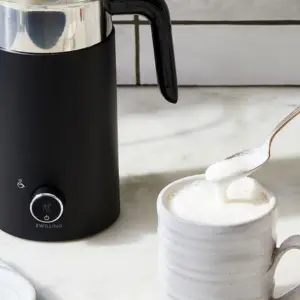In the realm of coffee and lattes, frothed milk serves as the crowning touch, imparting a silky texture and delightful richness to your beloved beverages. However, have you pondered which type of milk reigns supreme when it comes to frothing? In this all-encompassing guide, we will explore different milk choices, their frothing attributes, and the elements to weigh when selecting the Best Milk For Frother needs.
What Does The Term “Milk For Frother” Refer To?
“Milk for frothing” refers to the specific type of milk that is suitable and commonly used with a milk frother, whether it’s a manual frother or an electric frother. When people choose milk for frothing, they typically take into account particular qualities that make it well-suited for creating a creamy and frothy texture in their beverages.
Key Attributes of Choosing the Best Milk For Frother
Here are some key attributes of milk chosen for frothing:
Fat Content
Milk with a higher fat content tends to froth better and produce a creamier foam. Whole milk, with its higher fat percentage, is a popular choice for achieving a rich and luxurious froth. Reduced-fat milk options, such as 2% or 1%, can also yield good froth while providing a slightly lighter texture.
Protein Content
Protein plays a vital role in stabilizing the foam formed during frothing. Milk with a moderate protein content is preferable for frothing. Most dairy milk varieties naturally contain an adequate amount of protein for this purpose.
Texture
The texture of the milk is significant for achieving the desired froth. Creamier milk, like whole milk, results in a thick and velvety microfoam. Conversely, lighter milk types such as skim milk produce a more airy and delicate froth.
Types Of Milk Frother
Milk frothers are commonly employed to enhance the texture and flavor of both hot and cold beverages. There are two primary categories of milk frothers:
Manual Milk Frother
This type of frother typically consists of a cylindrical container crafted from glass or stainless steel. It is equipped with a plunger that has a fine mesh screen at the base. To manually froth the milk, you first heat it on the stove or in the microwave, then pour it into the container. Afterward, you create froth by repeatedly moving the plunger up and down, agitating the milk in the process.
Electric Milk Frother
Electric milk frothers are automated devices powered by electricity. They come in various designs, including handheld wand-style frothers and standalone machines. Utilizing an electric frother is straightforward: you heat the milk, pour it into a container, and immerse the frothing wand or whisk. The machine then rapidly froths the milk, typically within seconds, and produces a consistent, velvety foam.
Why Is The Selection Of Milk Important?
The choice of milk holds significant importance when using a frother. Your milk selection can profoundly impact both the frothing process and the overall quality of the frothed beverages you create. Here’s why your choice of milk matters for frothing:
Frothability
Different milk types contain varying levels of proteins and fats, which are key components in froth creation. Milk with higher protein and fat content tends to froth more effectively, resulting in a dense and creamy microfoam. Conversely, milk with lower protein and fat content may yield a lighter froth.
Texture
Your milk choice directly influences the texture of the frothed milk. Creamier milk options like whole milk produce a luxurious and velvety texture, ideal for lattes and cappuccinos. Lighter milk varieties, such as skim milk, produce a foam with a more airy and delicate consistency.
The Competitors: An Evaluation
Whole Milk
Whole milk, renowned for its lush and creamy consistency, stands as an exceptional option for frothing. Its elevated fat content generates a dense and opulent microfoam, making it an ideal companion for lattes and cappuccinos, elevating your daily coffee experience.
2% Reduced-Fat Milk
For individuals seeking to reduce calorie intake while preserving frothy goodness, 2% reduced-fat milk emerges as a popular choice. It strikes a balance between creaminess and a lighter texture, rendering it adaptable for a variety of frothed beverages.
Skim Milk
If health-consciousness guides your choices while maintaining a desire for frothed milk, skim milk serves as the go-to option. Although it may not offer the same level of creaminess as whole milk, it crafts a frothy layer with fewer calories, making it an excellent selection for guilt-free enjoyment.
Soy Milk
Soy milk provides an excellent dairy-free alternative. It froths effectively and boasts a naturally sweet flavor, making it an excellent fit for plant-based lattes. However, its frothing quality can vary among brands, necessitating some experimentation.
Almond Milk
Almond milk, another dairy-free contender gaining popularity, froths beautifully and imparts a subtle nutty essence to your beverages. To avoid unwarranted sweetness, opt for unsweetened varieties.
Oat Milk
Oat milk emerges as a rising star in the frothing arena. Its innate creaminess, exceptional frothing capability, and neutral taste profile make it a perfect match for coffee and tea, particularly for those with nut allergies.
Factors To Consider
Selecting the ideal milk for your frother involves taking several critical factors into account to ensure you achieve the desired froth quality and taste in your drinks. Here are the essential considerations when picking milk for your frothing needs:
Compatibility With Frothing Machine
Before adding your milk of choice, verify that it is compatible with your specific frothing machine. Certain frothers perform better with particular milk types due to their frothing mechanisms.
Dietary Restrictions
Take into account any dietary restrictions or preferences you may have. If you are lactose intolerant or follow a vegan diet, opt for dairy-free alternatives such as soy, almond, or oat milk.
Flavor Profile
Consider the flavor you wish to impart to your beverage. Dairy milk contributes a classic creaminess, while plant-based options introduce distinctive flavors such as nuttiness or the oat-inspired taste.
Beverage Choice
Consider the specific beverages you plan to prepare, as certain milk varieties are better suited for particular drinks. For instance, whole milk is a preferred choice for creating latte art because of its inherent creaminess.
Freshness Is paramount
Always use fresh milk for frothing. Milk nearing its expiration date or spoiled will not froth effectively and can adversely impact the flavor of your beverages.
Maintain The Appropriate Temperature
When frothing milk, typically around 150°F (65°C), as this ensures optimal froth consistency. Utilizing milk that is excessively hot or too cold can disrupt the frothing process and results.
Best Milk Frothers
Discovering the finest milk frother can significantly elevate your coffee and beverage crafting journey. Here are some top-notch milk frothers renowned for their quality, performance, and high user satisfaction:
Breville BMF600XL Milk Cafe Milk Frother
Breville’s electric milk frother stands out for its versatility and exceptional performance. It can create various milk textures, including silky microfoam for latte art, and provides temperature control for both hot and cold frothing.
Nespresso Aeroccino 4 Milk Frother
Designed to complement Nespresso coffee machines, the Aeroccino 4 is a favored choice known for its simplicity and efficiency. It froths milk for cappuccinos and lattes while also offering the option to prepare cold froth for iced beverages.
Secura Automatic Electric Milk Frother And Warmer
Secura’s electric milk frother is celebrated for its user-friendly operation and consistent frothing outcomes. It excels at both hot and cold milk frothing and includes a heating function to maintain frothed milk’s warmth.
HIC Milk Frother, Cappuccino Coffee Foam Pitcher
For those who prefer a manual frothing experience, HIC’s milk frother is a budget-friendly choice. It’s ideal for crafting frothed milk in smaller quantities, perfect for coffee enthusiasts.
Bodum Latteo Milk Frother
Bodum’s Latteo presents a manual milk frother with an elegant and straightforward design. It’s easy to use and clean, making it an excellent option for individuals who prefer manual frothing.
Tips For Frothing Success
Achieving successful frothing with your milk frother requires a blend of technique and meticulousness. Here are some valuable pointers to assist you in crafting the perfect froth for your beverages:
Begin With Fresh, Chilled Milk
Commence with fresh, cold milk. Milk that lacks freshness or has warmed to room temperature may not froth as effectively.
Preheat Your Frothing Gear
Before frothing, preheat your frothing pitcher or container. This helps maintain the froth’s temperature and prevents rapid cooling.
Froth At The Optimal Temperature
Strive to froth the milk at approximately 150°F (65°C). This temperature range is optimal for achieving a stable and velvety froth.
Avoid Overfilling
Refrain from filling your frothing pitcher or container to the brim. Allow ample space for the frothed milk to expand without spilling over.
Exercise Patience
Frothing demands time and practice. Be patient and let the frother perform its task without rushing the process.
Select The Appropriate Milk
Choose the milk variety that aligns with your taste preferences and frothing requirements. Whole milk is renowned for generating a creamy froth, while skim milk yields a lighter froth.
Maintain Regular Cleaning Of Frothing Equipment
Routinely clean your frothing wand, pitcher, or frothing container to prevent milk residue from adversely affecting froth quality.
Conclusion
Selecting the perfect milk for your frother is a unique journey. Whether you relish the creamy richness of whole milk or lean towards the health-conscious choice of almond milk, there’s a milk option tailored to your taste and dietary preferences. Embrace experimentation, savor the process, and elevate your daily coffee ritual with the frothed milk that suits you best. Discover further information on our website, Time Speed Magazine.
Best Milk For Frother FAQs
Can I Find Any Milk Variety?
While it’s possible to froth most milk types, the outcomes can differ. Some froth more effectively than others due to variations in their fat and protein content.
Is It Essential To Heat The Milk Before Frothing?
Preheating the milk contributes to the creation of a stable and velvety froth. It’s a recommended step for achieving optimal results.
Which Milk Is Ideal For Latte Art?
Whole milk is often favored for latte art due to its creamy texture and superior frothing capabilities.
Can I Use Expired Milk For Frothing?
Utilizing fresh milk is crucial for successful frothing. Expired milk may yield unsatisfactory results and affect the taste.
What’s The Perfect Frothing Temperature?
The ideal frothing temperature for most milk types is approximately 150°F (65°C), as it promotes the best froth consistency.


